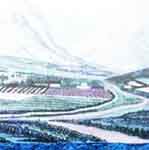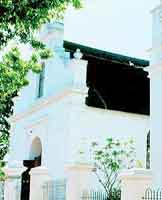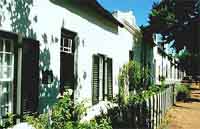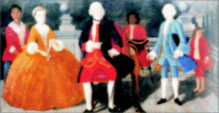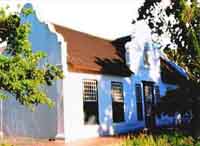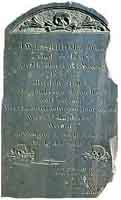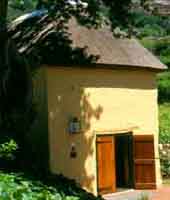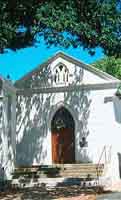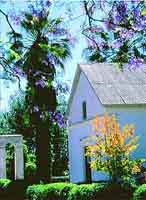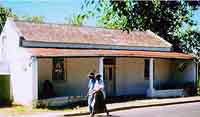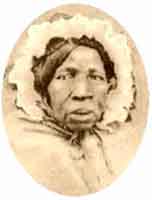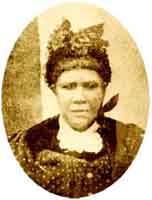Winelands
(Department of Cultural Affairs & Sport, Western Cape Government)
Slaves were the backbone of the colonial economy. They outnumbered Europeans, yet it is all but forgotten who built and maintained public buildings and roads in the colony, who did the back-breaking work in the vineyards and orchards of Boland farms, who helped to build the imposing homesteads and who made furniture, vats, wagons, clothes and other forms of cultural material that we still see around us today. Slave sales were held on farms and auctions took place in Stellenbosch. Slaves were punished and executed in Stellenbosch in public, as well as in the Old Goal. Arson, one of the most frequent transgressions, was punishable by hanging. |
|
||||||||||||||||||||||||||||||||
|
|||||||||||||||||||||||||||||||||
|
|||||||||||||||||||||||||||||||||
Rhenish Mission Church (on the Braak) The Stellenbosche Medewerkende Zendelings Genoodschap was established in 1801, and the name changed to Het Stellenbosche Zendelings Genoodschap in 1838. The society was concerned with the spiritual and educational needs of slaves. The first missionary and teacher was Meeuwes Janse Bakker and meetings were held at his house. Reverend Erasmus Smit took over in 1822. A church was built on a donated plot of ground and dedicated in 1824. After 1829 the Rhenish missionary Luckhoff worked among slaves on neighbouring farms and started evening schools for them. The congregation joined the Dutch Reformed Mission Church in South Africa in 1948 but kept the name of the Rhenish Dutch Reformed Mission Congregation. |
|||||||||||||||||||||||||||||||||
Row of slave houses in Herte Street The Rhenish Mission Church provided a row of houses for freed slaves in Herte Street. Bletterman House and Grosvenor House, Stellenbosch Museum (37 Ryneveld Street) Many of the old buildings making up the Village Museum in Stellenbosch have rich histories relating to slaves and slave owners. Kromme Rivier (Paul Kruger Street) This estate was granted as a farm to Jan Jansz van Eeden in 1683. Many structures were erected on this farm during its history, including a 1730's building where slaves are presumed to have been housed. It was changed considerably over time and today it is a double-storeyed flat. The property belongs to the Roman Catholic Church and is known as St Nicholas Roman Catholic Priory. |
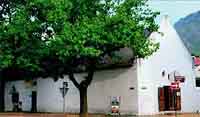 Bletterman House |
||||||||||||||||||||||||||||||||
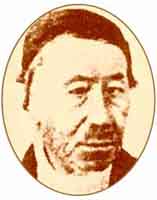 Rev. Erasmus Smit |
|||||||||||||||||||||||||||||||||
Elsenburg (on the R304) In 1752 Martin Melck became the owner of the farm. He was also one of the biggest slave owners at the Cape, having 200 slaves at his command. In his time the farmhouse, slave quarters, outbuildings and a school for slave children were erected. On smaller farms there were no special living quarters for slaves; they slept in kitchens, attics and barns, or out of doors in summer. A story exists about Moses of Bengal, a slave from Elsenburg who was sold to the owner of Loevenstein in Parow. He was mistreated by his new owner and ran back to Elsenburg where he set the slave lodge alight. His punishment was that he was burned alive. The old house, outbuildings and slave bell have survived and form part of the Elsenburg College of Agriculture campus. It is open to the public.
|
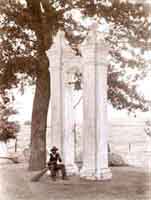 Elsenburg Slave Bell |
||||||||||||||||||||||||||||||||
| Lanzerac (Jonkershoek Road) Lanzerac, originally known as Schoongezigt, was granted partly to free blacks Manuel and Anthony of Angola, and Louis of Bengal, in 1692. Interestingly, they also owned slaves. Other free blacks settled in what is today known as Jonkershoek. Thus, Oude Nektar (originally Jan Lui) was owned by the free slaves Manquard and Jan of Ceylon in 1692. Jan of Ceylon also owned other properties in Jonkershoek. Free blacks were people of slave descent or former slaves who had, for a variety of reasons, been freed by their owners. Tel: 021 887 1132 |
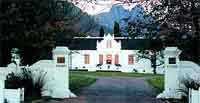 Lanzerac |
||||||||||||||||||||||||||||||||
| Spier Wine Estate (R310 Baden Powell Drive) The historic Spier estate is a well-established part of the wine route. The property was granted to Arnoud Jansz in 1692 although he had lived there since 1683. Many structures were built on the property, including a slave house. The former slave quarters now houses a restaurant. There is a slave bell which was used to signal the start and end of the working day. Tel 021 809 1100 |
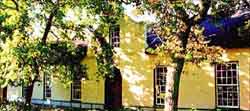 Spier Wine Estate |
||||||||||||||||||||||||||||||||
| Pniel (R310) The evangelisation of slaves and "heathens" in the Groot Drakenstein valley was started by a number of local Christian farmers. They provided land for religious activities in the area known as "Papieren Molen". After the emancipation of slaves, the land was extended to accommodate more residents. This mission station was founded in 1843 to look after the spiritual welfare of freed slaves. The churchyard had a church, a parsonage and a school. The original church building, now part of the present church, was dedicated and named Pniel in 1843 by the Reverend GW Stegmann of St Stephen's. In Pniel there is an area know as Masbiekvlei or Mozambiquevlei where freed slaves originally from Mozambique lived with their descendents. A Freedom Monument was erected in Pniel in 1992. Tel: Municipality 021 808 8501/2 - Linda Nichols |
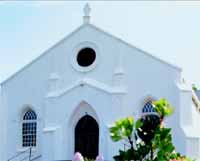 Pniel |
||||||||||||||||||||||||||||||||
Goede Hoop (R310) A modern slave bell, dated 1934, marks the centenary of the abolition of slavery. Boschendal (R310) The farm Boschendal, with its imposing buildings forming a formal werf, is a landmark of the wine route. During the period of slavery, a long building divided into individual rooms, adjacent to the stables and kraals, was constructed to house slaves. It is still there today. |
|||||||||||||||||||||||||||||||||
|
FRANSCHHOEK
Estate inventories of this area show that slaves were often the farmers' greatest assets. They were dependent on slaves for labour. In 1806 the thriving wine industry in the Franschhoek Valley created a group of prosperous farmers. Wine and brandy were exported to European countries, and access to British markets after the Second British Occupation of the Cape in 1806, contributed to the economic upswing. Farms were modernised and farmhouses were redecorated. The well-known Cape Dutch gable became a symbol of the new prosperity. Slaves not only worked in the vineyards and orchards, but also as builders, carpenters, blacksmiths, bricklayers and painters and were responsible for making doors, window frames, shutters, nails, as well as thatching. |
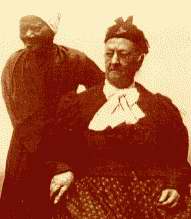 Anna Speas and Elisabeth Anna Kriel |
||||||||||||||||||||||||||||||||
|
PAARL
Paarl Museum (303 Main Road) Wilhelm Gebhart was sentenced to death for maltreating a slave who subsequently died on the farm Simonvlei near Paarl. Gebhart had the slave Joris flogged (139 lashes) for not working to his satisfaction. Joris was found dead the next day. After a protracted court case Gebhart was found guilty and sentenced to death. He was hanged on 15 November 1822. His gravestone is in the museum, a building which was once the Gebhart family's home. His father was the minister at the Strooidakkerk (Thatch Roof Church). An example of slave chains and entries into a transfer register can also be viewed in the museum. |
|||||||||||||||||||||||||||||||||
|
|||||||||||||||||||||||||||||||||
Het Gesticht (Main Road) Mission work started early in the 19th century in Paarl. Het Gesticht was erected in 1813 by the Friends of the Mission Movement with the aim of providing religious training to slaves and coloured people. Before this, slaves and coloured people attended church services in the Strooidakkerk (Thatch Roof Church in Main Street) but it soon became too small to serve the community. The Paarlse Sending Genootskap took over the building as well as the training programme in 1819. Nuwe Plantasie (Plantasie Street, behind Grand Roche Hotel) Hermanus Bosman was the sieketrooster from 1707 to 1748 in the Drakenstein congregation. He applied to the Council of Policy for land in 1715 which, on receiving, he called De Nieuwe Plantage. Here he built a church for his slaves in 1737. It is open to the public. |
|||||||||||||||||||||||||||||||||
Kleinbosch (R303, Dal Josafat) In the cemetery on this farm slaves called Ou Ta, (Klaas) Flora, and Clara, are buried. They were freed slaves who settled with the Du Toit family. Klaas worked on the farm and his wife Clara worked as a respected midwife from 1830 to 1850. Kleinbosch belonged to DF du Toit, farmer and owner of Kleinbosch, and the father of the Reverend SJ du Toit, the well-known theologian and leader of the first Afrikaanse Taalbeweging. It is open to the public. |
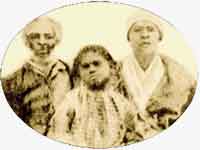 Ou Ta, (Klaas) Flora, and Clara |
||||||||||||||||||||||||||||||||
|
WELLINGTON
Wagenmakersvallei Mission Church (Bovlei) Mission work among the slaves and coloured people in Wagenmakersvallei started in 1796 under JJ van Zulk who counted at least "300 heathens" consisting of Khoekhoen and slaves. He erected a structure (Gesticht) for this purpose which has not survived. In 1802 Daniel le Roux was appointed as "oefenmeester". He built a church on land he received from the Governor.
This church was consecrated on 18 September 1820 by the Reverend Gebhart of Paarl. The church was enlarged in 1868 to its current size. Two holy communion cups that were used by the congregation are housed in the Wellington Museum |
|||||||||||||||||||||||||||||||||
|
|||||||||||||||||||||||||||||||||
| House of Martha Solomons (51 Bain Street) She was the daughter of a slave woman known as "Queen Rebecca" who owned a tavern in Cape Town after emancipation. Martha, who lived in Wellington, met and married Englishman Harry Grey, the black sheep of an aristocratic family. After the death of his cousin he inherited a title, and so his wife Martha, a slave descendent, became the 8th Countess of Stamford. Not open to the public. | |||||||||||||||||||||||||||||||||
| An interesting story is that of the Weigt slaves of Wagenmakersvallei. Their owners, Benjamin Weigt and Anna Lategan, were childless. They had all their slaves' children baptised in the Strooidakkerk in Paarl (1823) and all the slaves and their children were set free upon the death of their owners. | |||||||||||||||||||||||||||||||||

